5 basic skills will determine how much you sell

Business Development
343 week ago — 20 min read
Summary: Selling can be taught. Sales performance can improve dramatically. But only if we treat selling as a skill—not a personality type, not a work style, not a gift. If the goal is to boost sales performance, then the question we should ask about training programs built upon personality type or work style is: do they, in fact, reliably drive performance to higher levels? Jeevika Kher shares five basic skills that determines success of sales.
In a market economy, sales are self-evidently good, like oxygen. A company that can’t sell can’t survive. So it is hardly surprising that for many years we have sent salespeople to a multitude of training programs in an effort to teach them how to sell more stuff.
What is surprising is the way in which we have gone about it. To a remarkable degree, our efforts to boost sales performance have looked less like skill building than like exercises in zoological classification. We have categorized salespeople relentlessly, by personality type, by work style, and every other way we could think of.
What is your basic personality type? Are you a driver, amiable, expressive, or analytic? Or, as the Myers- Briggs Type Indicator would have it, perhaps you are an INTP or an ESFJ. As for work styles, which tend to be closely linked to personality types, we can spend time and effort to classify you as a hunter or a farmer. Or we can figure out whether you are a challenger, problem solver, hard worker, relationship builder, lone wolf, or something else.
Many of these typologies describe genuine differences in personality or style, and most of them make for interesting intellectual exercises. But if the goal is to boost sales performance, then the question we should ask about training programs built upon these classification systems is: do they, in fact, reliably drive performance to higher levels?
The evidence for that is sketchy. Personality types are more or less fixed and highly resistant to change. So companies are kidding themselves if they imagine that they can change salespeople from amiables into drivers, or farmers into hunters, or lone wolves into relationship builders. If the objective is not to try to change or “flex” styles but instead to weed out salespeople deemed to have the wrong personality types, we certainly never hear that explained. At least, not out loud, where a lawyer might hear it.
Or maybe we are persuaded that our top- performing salespeople will be those with a particular style, and we want to identify the ones with that style in order to concentrate our time, training, and motivational resources on them. But that leads to other problems. For one thing, what do we do with all of the non- favored sales reps; just leave them to wither on the vine? Also, even if we’re right to assume that our best performers all will be hunters or challengers or whatever (a huge “if”), when we concentrate training on top performers we quickly run into a law of diminishing returns. The potential return on investment is far greater when we turn a ‘C’ performer into a ‘B,’ or a ‘B’ into an ‘A,’ than when we try to turn an ‘A+’ into an ‘A++.’ (More on this later.)
Simple observation and experience tells us that in sales, as in other fields, there are such things as “naturals” who seem innately good at selling. They tend to remain outstanding performers, bless them, regardless of which sales-training programs they suffer through. But whether anyone has really devised a personality test that can reliably predict who these naturals will be...that is another question.
Fortunately, selling is a skill, not a style
It is pretty obvious that the biggest payoff for an investment in sales training—and the management and coaching time associated with training—would come if there were a way to make all salespeople more successful, regardless of their personality styles, work styles, or innate gifts.
You can’t teach personality, but you can teach skills. What’s more, you can measure skills, and you can measure the degree to which they improve. Selling is, of course, a skill. Or, to be more precise, selling involves a number of skills. The question is, which skills should you teach? And assuming you can figure that out, what kinds of results can you expect from teaching them?
The Big Five
Hundreds of skills may be involved in making a complex, business-to-business sale. But humans don’t have much luck trying to learn hundreds of skills at once. What’s more, managers can’t coach that many, and companies can’t measure, reinforce, or reward that many. If training is to have a significant impact on sales performance, it has to concentrate on building a manageable number of skills.
Since 2016 The Sales Board has assessed more than 1000 salespeople to determine the most important skills in the sales process. What emerge from the data are five critical selling skills. These are the skills which, when improved, produce the biggest gains in sales performance.
Since these five are, in fact, skills and not personality traits, they can be learned. They can be improved. And the improvements can be measured. If you want to make the greatest impact on sales performance, the data says that this is where to spend your time and energy.
1. The Buyer-Seller Relationship
This has to do with differentiating oneself from competitors by remaining in sync with the buyer’s decision-making process. When salespeople know how to move forward in a way that matches the buyer’s natural decision-making sequence, they treat the buyer with respect. That leads to lasting relationships.
2. Presentation Skills
These are important, but not in the way you probably believe. Most salespeople have been trained to think that two-thirds of their selling takes place during the presentation, when they describe their product features and benefits. In fact, the best presentations are brief and targeted to points that the buyer (with the help of the seller) has identified as unique and important needs.
3. Questioning Skills
The question is the salesperson’s most important tool. It is used for engaging the prospect, building rapport, discovering needs, agreeing on those needs, taking the temperature of the prospect, managing the sales conversation, and gaining commitment.
4. Sales Call Planning
Every sale is a series of steps, a progression of milestones. And every milestone demands that the salesperson get an agreement from the buyer—a commitment of some sort—that will move the sales process forward. That requires planning.
5. Gaining Commitment
This is the principle mission of every salesperson, yet most fail even to ask customers for a commitment that will lead to the next milestone in the sales process.
How sales skills work at work
What kinds of real-world changes occur when salespeople improve their performance in the five most critical sales skills? Managing the buyer/seller relationship is the skill in which salespeople’s self- perceptions exceed their actual performance by the widest margin. Veolia Environmental Services North America, a Chicago-based waste- management firm, grew revenue by $10 million after boosting its sales reps’ ability to stay in sync with the customer’s decision-making process.
“We weren’t doing a good job of matching our sales presentations to the sequence of buying decisions that the customer was making,” said Mark Dennis, Veolia’ vice president of sales and marketing. For instance, he said, “We’d be discussing our service capabilities while the customer was still deciding whether and how much to trust our sales rep. That’s a mismatch. And it’s the kind of thing that managing the buyer/seller relationship is actually about.”
But Veolia found the biggest payoff by improving its salespeople’s questioning skills. This is an area in which sales reps typically have a lot of knowledge but aren’t able to apply it constructively. Shortcomings show up on the job in many different ways. For example, Dennis said “We couldn’t figure out why our proposals weren’t being accepted. They were getting stalled.”
When Veolia investigated, he said, “It turned out that we weren’t involving all of the right buyers in the proposal-development process. That’s because we didn’t understand their roles. It was a symptom of not asking enough questions about the influencers involved in the buyer’s decision-making.” The solution was to not just ask questions, but to ask the BEST questions.
People who are new to sales positions require help with all five critical skills, but the needs are most pressing in three areas, according to David Green, chief operating officer of Supply Chain Services in Oakdale, Minn. When they fixed this, they grew the company by over 50% in one year.
“We hire a lot of salespeople who are in their first or second job out of college,” Green said He observes that new hires always seem to need work on the same two skills right away: “First, what does an effective sales call look like? They need to be able to plan their sales calls and have a vision about how the call will go. Second, they need questioning skills. That’s because the needs-analysis portion of our sales process is critical to be able to move a deal forward.”
Once salespeople have some experience under their belts, Green said, “we take questioning to a deeper level and begin to focus on developing the ability to consistently gain commitment in every sales call. “ Itis surprising but true that asking for commitment is the hardest skill for most salespeople to master, he said. “Because they fear that they will damage the relationship they’ve been working to develop, they just don’t ask. But if you don’t ask a customer for commitment, you won’t get it.”
Research findings on sales skills
From 2010 to 2012 The Sales Board surveyed and assessed 7,286 salespeople from 380 companies. The survey asked salespeople to self-rank each of the five critical selling skills. Then a validated skills assessment measured the critical skills in terms of both knowledge and ability to apply the knowledge.
The data sheds light on several key questions. What are the average skill levels in the general population of salespeople? How do self-perceptions of skills vary from actual knowledge and ability to apply the skills? What is the gap between current skill levels and mastery levels? And most important, what happens to performance when salespeople improve to mastery?
Note that all of these findings about skill levels and the potential for performance improvement apply to all salespeople, regardless of personality types or work styles. The data is relevant for drivers and expressive challengers and hard workers, ISTJs and ENFPs, Libras and Scorpios, salespeople who wear glasses, and those who don’t.
How do salespeople’s self-perceptions stack up against their actual performance on tests that measure knowledge and ability to use the five most critical selling skills? As Table 1 shows, both self-perceptions and assessments confirm that salespeople are weakest at gaining commitment. That is troublesome, since the principle mission of all salespeople— the reason they’re on the payroll—is to gain commitments from customers.
Table: 1
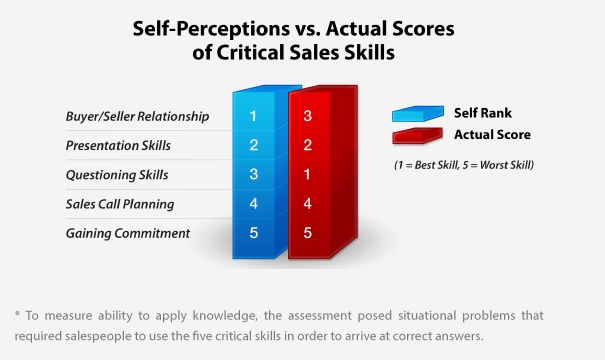
The greatest disconnect between perceptions and assessed skill levels lies in the fact that salespeople think they excel at managing the buyer/seller relationship, while the assessment says that this is far from their greatest strength. Probing revealed that this gap in perception versus reality occurs because salespeople misinterpret the meaning of the relationship. It is no longer about ball tickets and remembering which of the customer’s kids plays the clarinet. Today it’s all about having a deep-level understanding of the customer’s situation, proactively making recommendations, and consistently moving along with the customer toward the next commitment. That’s what managing the buyer/seller relationship means.
How far from mastery are most salespeople? If we set out to boost their sales performance with training, coaching, and reinforcement focusing on the five critical skills, how much room for improvement do we have?
The “mastery scores” shown in Table 2 were determined by The Sales Board, based on continuing assessments and experimentation dating back to 1995. Mastery scores represent the level at which performance peaks before further investments in learning reach a point of diminishing returns. In other words, it is possible to train salespeople beyond the mastery level in each skill, but the incremental gains in performance beyond mastery begin to show a smaller return on investment. What you begin to see is training programs that improve sales professionalism but don’t produce big increases in sales or margins. This is an illustration of why it may be a bad idea to spend a lot of time and money trying to turn “A+” performers into “A++’s.”
Table: 2
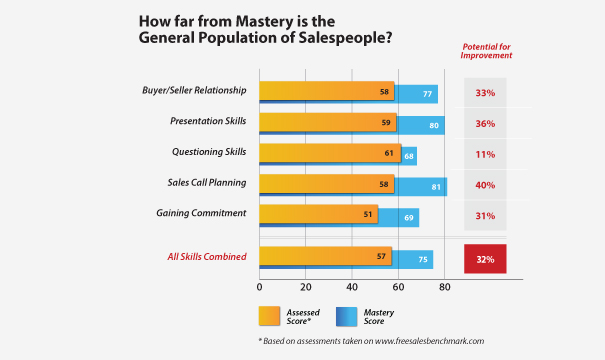
As Table 2 suggests, training salespeople to mastery level in the five skills has the potential to improve their performance dramatically. If we raise the average score for all five skills combined from 57 to 75, we have achieved a 32 percent improvement in overall skill level. This appears to represent a huge potential boost in sales performance.
On an individual basis, presentation skills appears to offer the greatest potential for improvement among average salespeople—38 percent. The skill of questioning appears to offer less potential—only 11 percent—most likely because many salespeople already have received training in questioning skills.
Table: 3
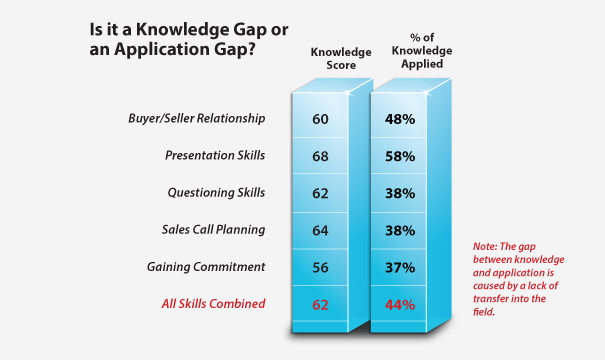
However, Table 2 doesn’t provide the whole picture because it doesn’t show the portion of skill that actually gets used in the field. Table 3 tells a more complete story about all skills, including presentation and questioning.
Knowing is not the same as doing, and knowledge is not the same as skill. You can learn all there is to know about the physics involved in riding a bicycle, but unless you can actually ride the bike you have not acquired the skill of bicycle riding. You aren’t skillful until you can do a thing skillfully. (This is one reason it is essential for salespeople to receive continued coaching, reinforcement, and measurement back on the job, after a training program.)
Table 3 shows how that distinction applies to selling skills. The general population of salespeople actually knows quite a bit about the five critical skills, posting an overall average score of 62 on the part of the assessment that measures knowledge. But salespeople manage to apply less than half of this knowledge (44 percent) in real-world situations.
Table 3 also points out that acquired knowledge in the skills of Gaining Commitment, Sales Call Planning and Questioning are the least applied. What has been learned is being poorly applied. No application? No skill.
What about the real world?
Companies don’t spend time and money on sales training because they want salespeople to learn labels for personality types. But companies also don’t invest in training because they want salespeople to score better on skills assessments. What matters is whether the trained salespeople go back to their jobs and sell more products and services at higher prices.
Table: 4
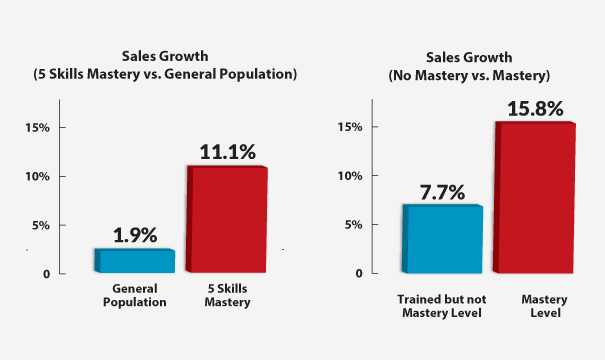
So what happens back in the real world if salespeople achieve mastery in the five critical skills? In the course of its research, The Sales Board tracked changes in sales and profit performance achieved by 1,077 salespeople for 274 days following training in the five skills.
All students received the same training; 765 achieved mastery level. The trained group as a whole—all 1,077 of them—improved their sales performance at six times the average growth rates of their industries. The mastery- level people boosted their performance a twice the rate of trained salespeople who did not achieve mastery. This demonstrates that the greater the knowledge and application of the five skills, the greater the performance change.
Predictable Impact
The Sales Board’s study of those trained rep also generated more specific, dollars-and- cents data about changes in sales performance Based upon that data, we can make confident predictions about the changes likely to occur when salespeople move from their current skill level to mastery in the five critical skills.
For example, suppose that a company’s salespeople generate annual revenue averaging $500,000 each, at an average gross margin of 25%. Suppose also that these salespeople currently would score at the level of the general population if assessed on the five critical skills. Table 5 shows the performance outcomes we can expect if we train them to mastery in the five skills.
Table: 5
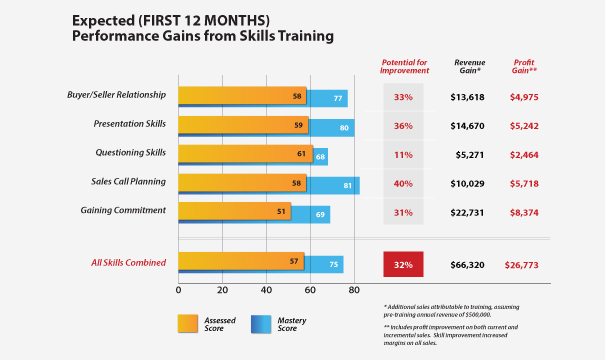
How to build skills
How can an organization teach these critical skills effectively so that salespeople really do achieve mastery? There are three keys. First, successful training has to be designed and conducted according to valid learning principles. Second, the learning has to be measured. Finally, the new skills must be reinforced by managers back on the job if they are to transfer into daily use.
One valid learning principle, for example, is that the salespeople should understand what it is you want them to learn and why it is important, not just to the organization but to them, personally. To begin with, that requires a well-documented sales methodology illustrating how the skills work and how they fit together.
Another learning principle is that if you want people to master a skill, you have to show them, clearly, what skillful performance looks and sounds like. Video-based training modules are great for this. An instructor can supplement them with role plays.
No matter how well training is designed, skills will not be mastered and used on the job unless they are reinforced. That involves things like repetition of the material and practice in real job situations. Above all, it demands involvement by managers who expect and insist that the new skills will be used.
Measurement is vital for several reasons, but the best way to say it in shorthand is this: What gets measured gets learned. Students should be assessed on the five critical skills before, during, and after training. Be sure to measure not just knowledge but application. When you find a gap, assign remedial training that focuses on the right need. If the problem lies in application of the learning, more knowledge won’t help.
None of this is arcane or mysterious. It doesn’t have to be. Sales training becomes much more straightforward when you conquer the urge to tinker with personality traits and start teaching skills that actually can be taught.
For more insights, attend our sales workshop in Chennai on 15 September, 2018.
To explore business opportunities, link with me by clicking on the 'Invite' button on my eBiz Card.
Disclaimer: The views and opinions expressed in this article are those of the author and do not necessarily reflect the views, official policy or position of GlobalLinker.
Network with SMEs mentioned in this article
View Jeevika 's profile
Other articles written by Jeevika Kher
Lessons in leadership from an ancient text on war
166 week ago
Coaching: A path to long term excellence
314 week ago
Ownership as an organisational culture
335 week ago
Most read this week


















Comments (6)
Share this content
Please login or Register to join the discussion